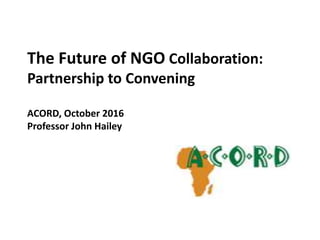The Future of NGO Collaboration: Partnership to Convening
- 1. The Future of NGO Collaboration: Partnership to Convening ACORD, October 2016 Professor John Hailey
- 2. Trends & Challenges Facing INGOs • Increasing fragmentation & disintermediation across the sector • Handling range of political pressures and regulatory demands • Growing competition for limited aid funds and associated changes to existing funding models • Continued pressure to demonstrate effectiveness and impact, • Implications of web-based communication & digital technologies • Adoption of new businesses models and practices. • New approaches to collaboration and co-creation, • Changing relationship with “partners”
- 3. Partnership – Is it still a Valued Concept? Partnership a contested concept • Many different definitions with different emphasis: solidarity, mutuality, trust & reciprocity, accountability, strategic alignment, coordination & effective use of resources. • But in general there has been a shift in thinking to a more instrumental or functional view of partnering and partnerships As a concept “partnership” has lost its ideological legitimacy or authenticity? • Has it become a “meaningless” term of convenience? Or do partnerships still have a distinct set of valued attributes? • Commonly used in a pragmatic way to describe a variety of relationships • Different typology of partnerships, along a “spectrum of partnerships”
- 4. Partnership The Functional/Solidarity Spectrum Functional: “means to an end” Solidarity: “an end in itself” A Functional Approach: partnership as a means to an end. Where cooperation is inherently operational and project-based. Such instrumental partnerships are often relatively transitory and based on a schedule of activities and defined results. Increasingly seen as a “sub-contracting” relationship. Solidarity-based Approach: partnerships as an end in itself. Typically where there is a long history of working in partnership to promote a public good. This approach draws often draws on an idealised (even ideological), trust-based notions of partnership.
- 5. Example of a Partnership Framework Save the Children 2016 “mission driven but based on mixed messages” Partnership is a long-term relationship between two or more organisations/institutions with a mutually agreed set of principles and accountabilities, working towards defined objectives that facilitate lasting change for children. Goals and objectives in partnership: Partnership as an approach delivers more than our need to fulfil our own program objectives. Save the Children is committed to achieving breakthroughs for children that are ambitious and go beyond the scope of any single organisation. This should happen in close collaboration with partners and in a spirit of mutual learning and responsibility. In that process, we help to strengthen national development capacity, including of civil society and other development actors. Purpose of Partnership Framework: to ensure that across the Save the Children movement, we have a shared understanding of what partnership and partnering mean, that we know how to do it and who supports it. Why Develop a Partnership Framework: risk mitigation, promote coordination, facilitating resource creation, ensure strategic alignment
- 6. International Collaboration • Recognition the diversity of terminology & language – Partnership, coalition, networks, alliance, platform, etc – Shift in use of language to Collaboration – Co-Creation - Convening • Such collaborative relationships seen as mission-driven with a strategic logic, but also have inherent tensions • Recognise that successful collaboration based on different strategic capabilities and competencies
- 7. Strategic Capabilities & Competencies ”the organisational assets that enable you to deliver your mission” • The building blocks of your strategy which help you prepare for an uncertain future • The means of mobilising & integrating the resources & competencies to ensure sustainability & delivering value Resources (the assets of that an organisation can call upon) - “what we have” Competencies (the way that the assets are used or deployed) -“what we do well at” • As a sector INGOs traditionally focused on tangible capabilities (funds, structures, systems); but there is increasing recognition of the importance of intangible capabilities including: Building relations & brokering relationships (relational capabilities) Transformational leadership & change (change capabilities) Creativity & scaling up innovation (innovative capabilities) Promoting values & shared mind-set (identity capabilities) Demonstrating agility & Smart working (responsive capabilities) Mobilizing talent, knowledge & learning (knowledge capabilities)
- 8. Relational Capabilities & Competencies Key Capabilities • To build and broker relationships • To maintain & deepen relationships • To handle/manage tensions around ownership, control & money • To develop the capacity to support collaborative relationships In Practice • Applying appropriate relational skills (communication, trust building, trust building, cross-cultural sensitivities, etc) • Demonstrating sufficient understanding/knowledge of current context/issues • Ability to disseminate & share information & data • Managing appropriate systems & processes to support collaboration at an organisational and inter-organisational level • Handling tensions around how differences in size & capacities distort relationships & dialogue
- 9. What are the key relational capabilities needed to promote collaboration, co-creation & convening? Does ACORD have such relational capabilities? Are they identifiable? Are they valued? Are they included in recruitment and appraisal processes?

